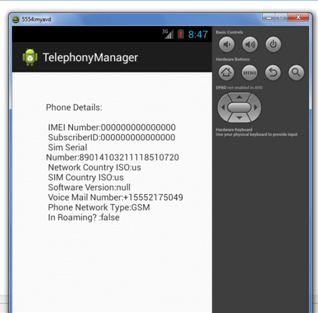Android Tutorial
Android Widgets
- UI Widgets
- Android Button
- Android Toast
- Android Custom Toast
- Android ToggleButton
- Android CheckBox
- Android Custom CheckBox
- Android RadioButton
- Android Dynamic RadioButton
- Custom RadioButton
- AlertDialog
- Spinner
- Auto Complete Text View
- ListView
- Custom ListView
- RatingBar
- WebView
- SeekBar
- DatePicker
- TimePicker
- Analog clock and Digital clock
- ProgressBar
- ScrollView Vertical
- HorizontalScrollView
- Image Switcher
- Image Slider
- ViewStub
- TabLayout
- TabLayout with FrameLayout
- SearchView
- SearchView on ToolBar
- EditText with TextWatcher
Activity and Intents
Android Fragments
Android Menu
Android Service
Android AlarmManager
Android Storage
Android SQLite
XML and JSON
Android Multimedia
Android Speech
Android Telephony
Android Device
Camera Tutorial
Sensor Tutorial
Android Graphics
Android Animation
Android Web Service
Android Examples
- QR Code / Bar Code Scanner
- RSS Feed Reader
- Volley Library Fetching JSON Data from URL
- Linkify Example
- Introduction Slider (Launch very first time when app start)
- RecyclerView List
- Swipe to Delete RecyclerView items with UNDU
- Swipe to refresh Android Activity
- Volley Library - Registration, Log-in, and Log-out
- Network Connectivity Services
- Firebase Authentication - Google Login
- Android Notification
- Using Google reCAPTCHA in Android Application
Android Social
Android Versions
Android Misc
- Android Device Manager
- Android Studio
- Android Auto
- Android to Mac
- Android Messages
- Android TV
- Android Screenshot
- Android Pay
- Android Watch
- Android Phones
- Android Tablet
- Android Find My Phone
- Android One
- Android Wear OS
- Android Data Recovery
- Android Antivirus
- Android x86
- Android Emulator for PC
- Android File Manager
- Android ad blocker
- Android Podcast App
- Fortnite Android an Epic Game
- FaceTime on Android
- ShowBox for Android
- Android App Store
- Virus Removal for Android
- cache in Android
- Root Android Device
- Android Screen Recorder
- block a number
- Canon printer app
- Wireless HP printer app
- How to Update Android
- iMessage for Android
- iCloud for Android
- Best Call Recorder
- Videoder Android
- YouTube Video Downloader
- Airdrop for Android
- RoboKiller for Android
- Clean my Android Phone
- How to hide apps, files, and photos on Android
- Best weather apps with widgets for Android
- Android File Transfer for Mac
- Mobdro for Android
- Screen Mirroring in Android
- Stock market apps for Android
- How to turn On or Off safe mode on Android
- Best browsers for Android
- Best clocks for Android
- Best email apps for Android
- Music player for Android
- Android smartwatch for women
- Best keyboard for Android
- Best messaging app for Android
Android MCQ
Android Interview
Android Quiz
TelephonyManager Tutorial
The android.telephony.TelephonyManager class provides information about the telephony services such as subscriber id, sim serial number, phone network type etc. Moreover, you can determine the phone state etc.
Android TelephonyManager Example
Let's see the simple example of TelephonyManager that prints information of the telephony services.
activity_main.xml
Drag one textview from the pallete, now the xml file will look like this.
File: activity_main.xml
<RelativeLayout xmlns:androclass="http://schemas.android.com/apk/res/android"
xmlns:tools="http://schemas.android.com/tools"
android:layout_width="match_parent"
android:layout_height="match_parent"
android:paddingBottom="@dimen/activity_vertical_margin"
android:paddingLeft="@dimen/activity_horizontal_margin"
android:paddingRight="@dimen/activity_horizontal_margin"
android:paddingTop="@dimen/activity_vertical_margin"
tools:context=".MainActivity" >
<TextView
android:id="@+id/textView1"
android:layout_width="wrap_content"
android:layout_height="wrap_content"
android:layout_alignParentLeft="true"
android:layout_alignParentTop="true"
android:layout_marginLeft="38dp"
android:layout_marginTop="30dp"
android:text="Phone Details:" />
</RelativeLayout>
xmlns:tools="http://schemas.android.com/tools"
android:layout_width="match_parent"
android:layout_height="match_parent"
android:paddingBottom="@dimen/activity_vertical_margin"
android:paddingLeft="@dimen/activity_horizontal_margin"
android:paddingRight="@dimen/activity_horizontal_margin"
android:paddingTop="@dimen/activity_vertical_margin"
tools:context=".MainActivity" >
<TextView
android:id="@+id/textView1"
android:layout_width="wrap_content"
android:layout_height="wrap_content"
android:layout_alignParentLeft="true"
android:layout_alignParentTop="true"
android:layout_marginLeft="38dp"
android:layout_marginTop="30dp"
android:text="Phone Details:" />
</RelativeLayout>
Activity class
Now, write the code to display the information about the telephony services.
File: MainActivity.java
package com.javatpoint.telephonymanager;
import android.os.Bundle;
import android.app.Activity;
import android.content.Context;
import android.telephony.TelephonyManager;
import android.view.Menu;
import android.widget.TextView;
public class MainActivity extends Activity {
TextView textView1;
@Override
protected void onCreate(Bundle savedInstanceState) {
super.onCreate(savedInstanceState);
setContentView(R.layout.activity_main);
textView1=(TextView)findViewById(R.id.textView1);
//Get the instance of TelephonyManager
TelephonyManager tm=(TelephonyManager)getSystemService(Context.TELEPHONY_SERVICE);
//Calling the methods of TelephonyManager the returns the information
String IMEINumber=tm.getDeviceId();
String subscriberID=tm.getDeviceId();
String SIMSerialNumber=tm.getSimSerialNumber();
String networkCountryISO=tm.getNetworkCountryIso();
String SIMCountryISO=tm.getSimCountryIso();
String softwareVersion=tm.getDeviceSoftwareVersion();
String voiceMailNumber=tm.getVoiceMailNumber();
//Get the phone type
String strphoneType="";
int phoneType=tm.getPhoneType();
switch (phoneType)
{
case (TelephonyManager.PHONE_TYPE_CDMA):
strphoneType="CDMA";
break;
case (TelephonyManager.PHONE_TYPE_GSM):
strphoneType="GSM";
break;
case (TelephonyManager.PHONE_TYPE_NONE):
strphoneType="NONE";
break;
}
//getting information if phone is in roaming
boolean isRoaming=tm.isNetworkRoaming();
String info="Phone Details:\n";
info+="\n IMEI Number:"+IMEINumber;
info+="\n SubscriberID:"+subscriberID;
info+="\n Sim Serial Number:"+SIMSerialNumber;
info+="\n Network Country ISO:"+networkCountryISO;
info+="\n SIM Country ISO:"+SIMCountryISO;
info+="\n Software Version:"+softwareVersion;
info+="\n Voice Mail Number:"+voiceMailNumber;
info+="\n Phone Network Type:"+strphoneType;
info+="\n In Roaming? :"+isRoaming;
textView1.setText(info);//displaying the information in the textView
}
}
import android.os.Bundle;
import android.app.Activity;
import android.content.Context;
import android.telephony.TelephonyManager;
import android.view.Menu;
import android.widget.TextView;
public class MainActivity extends Activity {
TextView textView1;
@Override
protected void onCreate(Bundle savedInstanceState) {
super.onCreate(savedInstanceState);
setContentView(R.layout.activity_main);
textView1=(TextView)findViewById(R.id.textView1);
//Get the instance of TelephonyManager
TelephonyManager tm=(TelephonyManager)getSystemService(Context.TELEPHONY_SERVICE);
//Calling the methods of TelephonyManager the returns the information
String IMEINumber=tm.getDeviceId();
String subscriberID=tm.getDeviceId();
String SIMSerialNumber=tm.getSimSerialNumber();
String networkCountryISO=tm.getNetworkCountryIso();
String SIMCountryISO=tm.getSimCountryIso();
String softwareVersion=tm.getDeviceSoftwareVersion();
String voiceMailNumber=tm.getVoiceMailNumber();
//Get the phone type
String strphoneType="";
int phoneType=tm.getPhoneType();
switch (phoneType)
{
case (TelephonyManager.PHONE_TYPE_CDMA):
strphoneType="CDMA";
break;
case (TelephonyManager.PHONE_TYPE_GSM):
strphoneType="GSM";
break;
case (TelephonyManager.PHONE_TYPE_NONE):
strphoneType="NONE";
break;
}
//getting information if phone is in roaming
boolean isRoaming=tm.isNetworkRoaming();
String info="Phone Details:\n";
info+="\n IMEI Number:"+IMEINumber;
info+="\n SubscriberID:"+subscriberID;
info+="\n Sim Serial Number:"+SIMSerialNumber;
info+="\n Network Country ISO:"+networkCountryISO;
info+="\n SIM Country ISO:"+SIMCountryISO;
info+="\n Software Version:"+softwareVersion;
info+="\n Voice Mail Number:"+voiceMailNumber;
info+="\n Phone Network Type:"+strphoneType;
info+="\n In Roaming? :"+isRoaming;
textView1.setText(info);//displaying the information in the textView
}
}
AndroidManifest.xml
You need to provide READ_PHONE_STATE permission in the AndroidManifest.xml file.
File: AndroidManifest.xml
<?xml version="1.0" encoding="utf-8"?>
<manifest xmlns:androclass="http://schemas.android.com/apk/res/android"
package="com.javatpoint.telephonymanager"
android:versionCode="1"
android:versionName="1.0" >
<uses-sdk
android:minSdkVersion="8"
android:targetSdkVersion="17" />
<uses-permission android:name="android.permission.READ_PHONE_STATE"/>
<application
android:allowBackup="true"
android:icon="@drawable/ic_launcher"
android:label="@string/app_name"
android:theme="@style/AppTheme" >
<activity
android:name="com.javatpoint.telephonymanager.MainActivity"
android:label="@string/app_name" >
<intent-filter>
<action android:name="android.intent.action.MAIN" />
<category android:name="android.intent.category.LAUNCHER" />
</intent-filter>
</activity>
</application>
</manifest>
<manifest xmlns:androclass="http://schemas.android.com/apk/res/android"
package="com.javatpoint.telephonymanager"
android:versionCode="1"
android:versionName="1.0" >
<uses-sdk
android:minSdkVersion="8"
android:targetSdkVersion="17" />
<uses-permission android:name="android.permission.READ_PHONE_STATE"/>
<application
android:allowBackup="true"
android:icon="@drawable/ic_launcher"
android:label="@string/app_name"
android:theme="@style/AppTheme" >
<activity
android:name="com.javatpoint.telephonymanager.MainActivity"
android:label="@string/app_name" >
<intent-filter>
<action android:name="android.intent.action.MAIN" />
<category android:name="android.intent.category.LAUNCHER" />
</intent-filter>
</activity>
</application>
</manifest>
Output:



